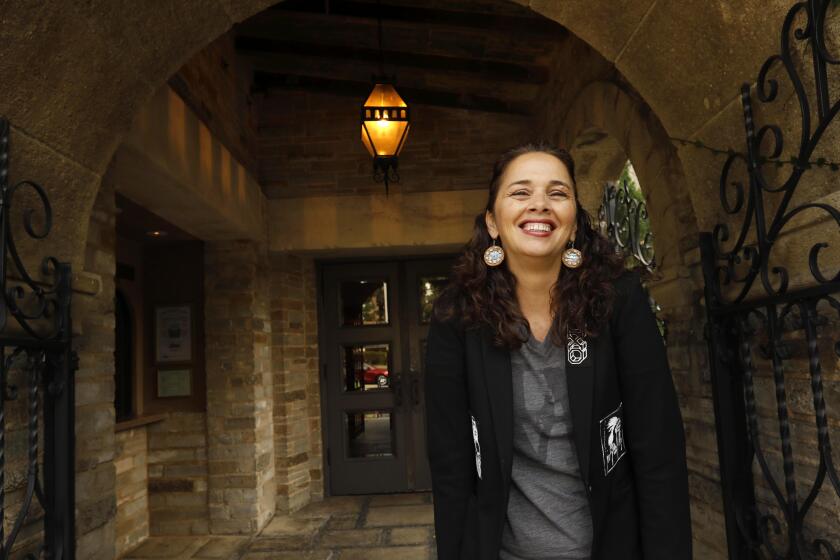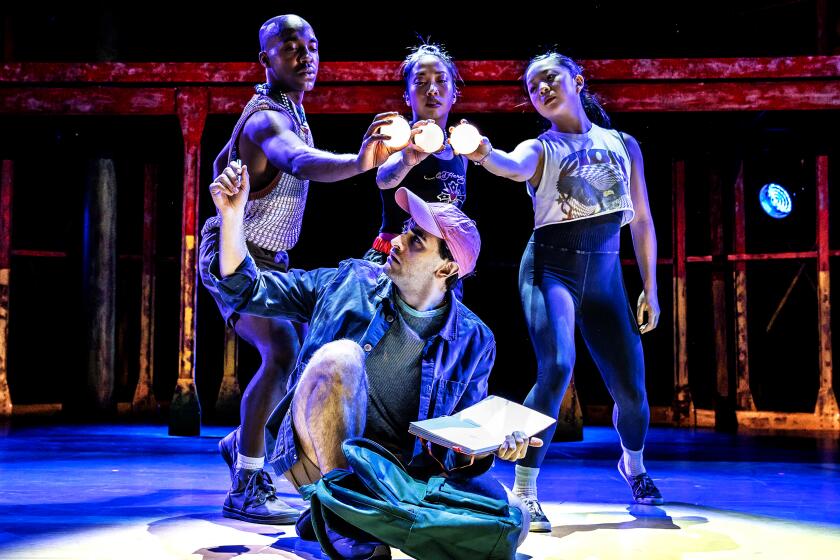O.C. ART REVIEW : ‘Western’ Goes in the Wrong Direction
Suppose various African people who made carvings and weavings much admired by their townspeople also collected handmade artifacts from the United States.
Now, imagine that these African collectors were to display their foreign treasures in a museum. Photographs would show how imported pieces of painted canvas or hunks of soldered metal looked in their owners’ homes, positioned next to the TV or a color photo of Michael Jackson or a bowl of fruit.
But there would be no cultural information about the foreign art. It would be showcased simply to highlight the interesting taste of the African craftspeople, who were enthralled by the exotic shapes and colors produced by a distant land of great violence and wealth.
If this imaginary show sounds odd, consider “Western Artists/African Art,” a well-meaning but ill-conceived project that has traveled to the Newport Harbor Art Museum, where it continues through Sept. 10. This exhibition of African artifacts collected by American artists was organized by the Museum of African Art in New York.
The show shines a broad spotlight on the art tastes of 24 mostly well-known Caucasian and African American artists living in the United States. They collect weavings, musical instruments, figure carvings, furniture, masks and other household objects from several Central and West African countries. (One memorable small iron figure was made by an unknown African American artist from Virginia, an inclusion that unfortunately only reinforces the show’s aura of noblesse oblige and cultural insensitivity.)
Most of the 32 objects have undeniable visual, even tactile appeal. A wood granary door made by the Dogon people of Mali studded with small raised designs and two pairs of breasts; a delicately incised bronze gong from the Asante culture of Ghana; a wryly self-contained wood figure from the Lega culture of Zaire--such pieces pique the interest of anyone with a visual sensibility.
But why exhibit them as so many attractive trophies, with no reference to their meanings, uses or cultural embodiment? Because, in the words of the show’s curator, Daniel Shapiro--an attorney who sits on the board of the New York museum, recently relocated to downtown Manhattan--the show is supposed to facilitate “a meeting between Africa and the Soho art world.”
Translation: Let’s once again see how much the fe^ted “high’ artists of the West admire the work of those anonymous craftspeople Over There, in Third Worldland. In a global society still attempting to eradicate the vestiges of colonialism, this show is a dated monologue about Western taste rather than a dialogue between cultures whose notions of art production remain radically different.
To be sure, Western artists from the Cubist period onward have found startling visual and conceptual ideas in African sculpture. But after the passage of almost a century, the West’s contemporary borrowings are no longer particularly novel. The real news is how certain African artists are combining their own traditions with elements of Western pop culture to make hybrid forms. Interestingly enough, none of this work is in the show.
“Western Artists” may be the first openly to introduce the approach of Architectural Design magazine into an art museum, with color photographs of the artists’ African art collections, ever so casually displayed in white-walled living rooms. Given the exhibition’s decorator sensibility, it comes as no real surprise that it was curated by an amateur, not an art history-trained curator.
The sole element of scholarly rigor is an astute catalogue essay by Jack Flam, a professor of art history at Brooklyn College and City University of New York, about 20th-Century Western artists’ shifting views of African art. He does not, however, discuss the issues raised by exhibiting Western artists’ African art collections.
The African pieces in the show are augmented by a sampler of the Americans’ own art, borrowed from private and public California collections. On the negative side, these 34 pieces--two more than the total number of African works--make the show even more Eurocentric by virtue of their overwhelming presence and our easy familiarity with their context. More positively, they (and the small illustrations in the catalogue) permit firsthand observation of possible relationships between the African and American works. The problem--not for the artists, of course, but for the credibility of the show--is that these relationships don’t always exist.
There are some obvious links. One of Lorna Simpson’s photo series includes images of the backs of her masks from Mali, as a way of probing connections between African and African American identity. Philip Pearlstein’s wooden chair from Ghana furnishes at least two of his images of female nudes. Fred Wilson is represented by an Ivory Coast mask he has altered by binding the eyes and mouth with symbols of colonialism: fragments of a British flag.
Other artists’ work can be said to possess certain qualities in common with the objects in their collections, although this may be more a matter of aesthetic sympathy than outright borrowing.
Terry Winters’ dense, allusive markings in crayon share some of the searching organic quality of a painted bark cloth from Zaire in his collection, and Francesco Clemente’s crouching terra-cotta figures from Mali possess something of the Italian-born artist’s predilection for awkward and bodily postures.
But most of the Americans make work that has little to do with the African objects in their homes. Several openly or indirectly reveal that they know little or nothing about the meaning, use or background of their pieces.
Wall texts (and catalogue pages) of quotes from the Americans include a broad spectrum of feelings about African art, from remarks about “power” and “spirituality” or formal elegance, to worries--mostly voiced by African Americans--about the appropriateness of typical First World views of the Third World.
Wilson’s is the most provocatively engaging voice in this many-voiced monologue. He asks how we can distinguish between “real” and “fake” (i.e., made for export) African art, if both were “a part of African life,” and questions the genuineness of a piece made for ceremonial use “when it’s on a bedroom wall or in a Plexiglas display case?”
Perhaps the most depressing thing about the show is its earnest smugness, as if, by giving equal time to a range of remarks about collecting African art, it can be acquitted of cultural bias.
How much more to the point the exhibition would have been had it dug below the surface of African art as an artist-endorsed “collectible” and engaged with the issues surrounding cross-cultural taste and influence.
* “Western Artists/African Art,” through Sept. 10 at Newport Harbor Art Museum, 850 San Clemente Drive, Newport Beach. Hours: 10 a.m. to 5 p.m. Tuesday through Thursday and Saturday; 10 a.m. to 7 p.m. Friday; noon to 5 p.m. Sunday. $4 adults, $2 students and senior citizens, free on Tuesdays. (714) 759-1122. * GETTING THE MESSAGE
“Western Artists” is all about perception, a museum official says. F2
More to Read
The biggest entertainment stories
Get our big stories about Hollywood, film, television, music, arts, culture and more right in your inbox as soon as they publish.
You may occasionally receive promotional content from the Los Angeles Times.





